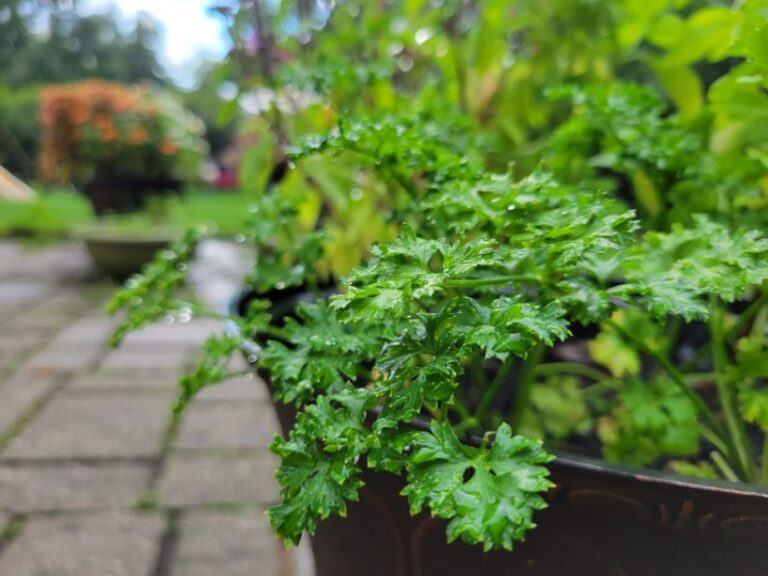This post may contain affiliate links which means I may receive a commission for purchases made through links. I only recommend products that I have personally used. As an Amazon Associate I earn from qualifying purchases. Learn more on my Private Policy page.

Parsley has a distinctive flavor that can be a culinary gem when harvested at its prime. As you cultivate your parsley plants, knowing the best methods for harvesting parsley is essential for optimizing both taste and plant vitality. Parsley preservation techniques are equally as important to ensure you have a parsley supply for cooking well after the growing season.
How do you know when to harvest parsley?
Harvest parsley when it’s 6-8 inches tall (15-20 cm), starting with the outer leaves. Look for 2-3 inch long leaves with a gentle curl and 3 segments. Harvest parsley before it starts flowering for best flavor and quality. Early harvest promotes growth and prevents woodiness.
How do you harvest parsley so it keeps growing?
For sustained parsley growth, start harvesting the outer leaves on parsley once it reaches a height of at least 6-8 inches (15-20 cm). Prune the mature stems first, leaving the inner ones to grow. Never harvest more than 1/3 of the plant to maintain photosynthesis.
Table of Contents
See my Comprehensive Guide to Parsley for a deeper dive into this vibrant herb.
When to Harvest Parsley
You can begin harvesting the outer leaves from your parsley plants when they reach about 6 to 8 inches in height (15-20 cm). This early-stage harvesting encourages continuous growth and prevents the plants from becoming too woody.
While parsley generally matures in 70-90 days after planting, a more accurate gauge on when you should begin harvesting parsley is to pay heed to specific cues:
- Parsley leaves should be 2-3 inches in length
- Leaves should display a gentle curl
- Leaves should feature 3 separate segments
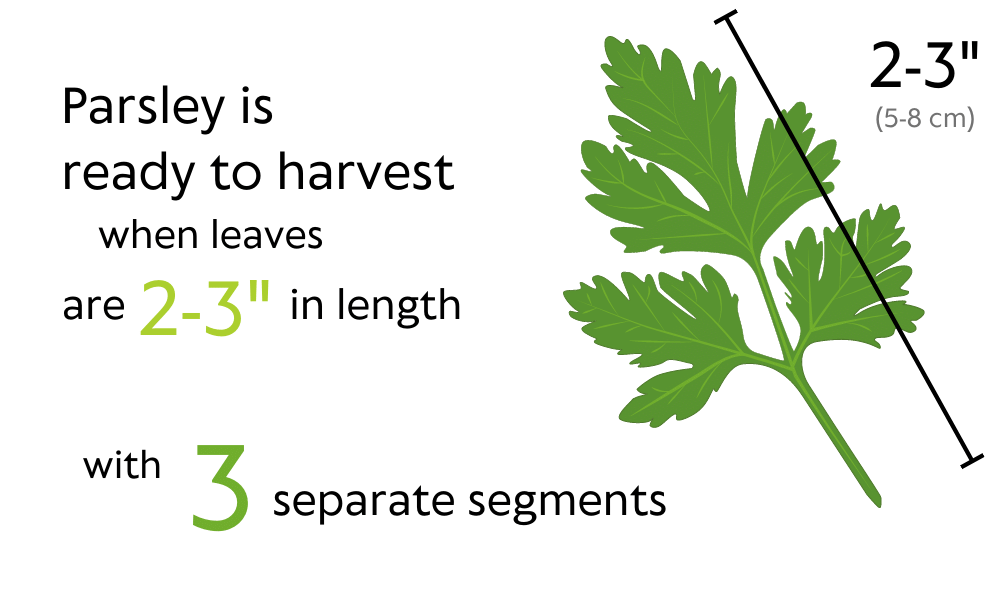
Understanding the growth stages leading up to this point can help to determine timing. Parsley germination alone can take as long as 5 or 6 weeks depending upon variety and conditions, with an additional 3 to 5 weeks before transplanting readiness, followed by 2 to 4 weeks of plant establishment before harvesting should begin.
To ensure the best flavor and quality, you should harvest parsley before the plant starts producing flowers, as this can lead to a decline in leaf flavor and texture.
How to Harvest Parsley for a Healthy Plant
For a plentiful parsley harvest and thriving plants, just follow these easy tips:
- Cut the Outer Stems First: Begin harvesting the outer parsley stems, leaving inner ones for ongoing growth.
- Prune Full, Mature Stems: Focus on harvesting robust stems with vibrant green leaves, snipping them close to the base. Don’t harvest just from the tops of the stems.
- Never Harvest More then 1/3 of the Plant: Ensure you never overharvest. It’s important to leave enough foliage for continued photosynthesis
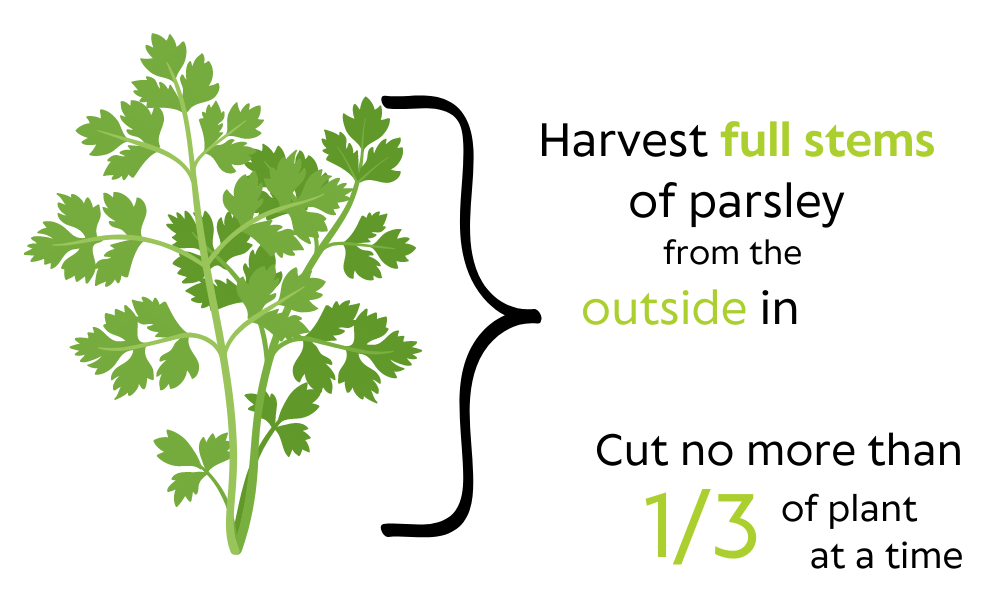
By following these simple guidelines, your efforts will yield a bountiful harvest and sustain your parsley plant’s well-being.
Preserving the Vibrancy of Fresh Parsley
Preserving the freshness and vibrancy of parsley is essential to fully enjoy its unique qualities. Common preservation techniques for fresh parsley include refrigeration with damp paper towels, blanching, and freezing.
Refrigeration with Damp Paper Towels
A tried and true method to preserve fresh parsley for short-term use is by refrigerating it with damp paper towels. Just follow these steps:
- Trim off any wilted or discolored parts from your fresh bunch of parsley.
- Slightly dampen a couple of sheets of paper towel and wring out any excess moisture.
- Wrap your parsley bunch with the damp paper towels.
- Place it in an airtight container or sealable plastic bag.
- Store in your refrigerator’s vegetable crisper drawer.
The moisture from the damp paper towels helps keep the parsley hydrated while preventing wilting and loss of color. You can store fresh parsley in the refrigerator for up to 5 days.
Blanching Techniques for Color & Flavor Retention
Blanching is a simple yet effective method to preserve both the bright green color and the fresh flavor of parsley. Blanching helps set parsley’s green color by deactivating enzymes that cause discoloration while retaining essential oils responsible for its distinct aroma and taste.
To blanch fresh parsley, follow these steps:
- Wash the parsley thoroughly under cold water to remove any dirt or debris.
- Bring a pot of water to boil and prepare an ice bath in a separate bowl.
- Submerge the washed parsley for about 10 seconds in the boiling water.
- Quickly transfer the blanched parsley into the ice bath to halt the cooking process.
- Once cooled, gently pat dry with paper towels before storing.
This blanching technique works particularly well if you intend to freeze the parsley for longer-term use.
Freezing Parsley for Longevity
Freezing parsley is an excellent way to extend its shelf life. Here’s how you can freeze fresh parsley:
- Wash the parsley thoroughly and pat it dry.
- Remove the leaves from the stems, as the stems tend to become tough when frozen.
- Consider blanching your parsley for better preservation of color and taste (see above)
- Spread the leaves in a single layer on a baking sheet or tray lined with parchment paper.
- Place the tray in the freezer for a few hours until the leaves are completely frozen.
- Transfer the frozen parsley into a resealable plastic bag or an airtight container, removing any excess air before sealing and placing it in the freezer for long-term storage.

Frozen parsley can be used directly from the freezer in soups, stews, sauces, or any cooked dish that requires parsley.
Remember to experiment with different preservation methods to find what works best for your needs and preferences.
Drying Parsley for Extended Use
Drying parsley is an excellent way to extend its shelf life while preserving its vibrant flavor.
To dry parsley, I suggest using a food dehydrator or using the air fryer method for the best results. See my article on How to Dry Parsley: 4 Easy Methods to learn the best methods for drying parsley and for step-by-step instructions on how to do them. Common ways to dry parsley include:
- Using a food dehydrator
- Air fryer method
- Oven method
- Air drying
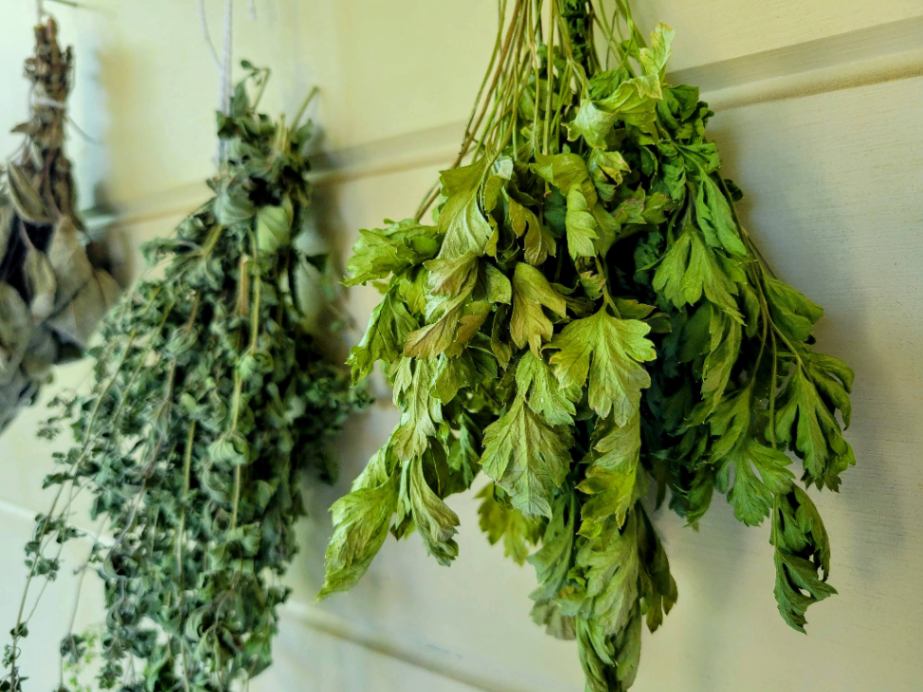
If you’re short on time and need dried parsley in a pinch, using a microwave can be another quick option to dry parsley:
- Wash your freshly harvested parsley thoroughly.
- Remove the leaves from their stems and discard any damaged parts.
- Place a few paper towels on a microwave-safe plate and arrange the clean leaves on top, ensuring they are not overlapping.
- Cover the leaves with another layer of paper towels to absorb excess moisture during microwaving.
- Set your microwave to medium-high power and heat in 20-second intervals, checking after each interval until the parsley is dry and crumbles easily when touched (usually takes around 2-4 minutes in total).
- Allow the dried parsley to cool completely before transferring it into an airtight container.
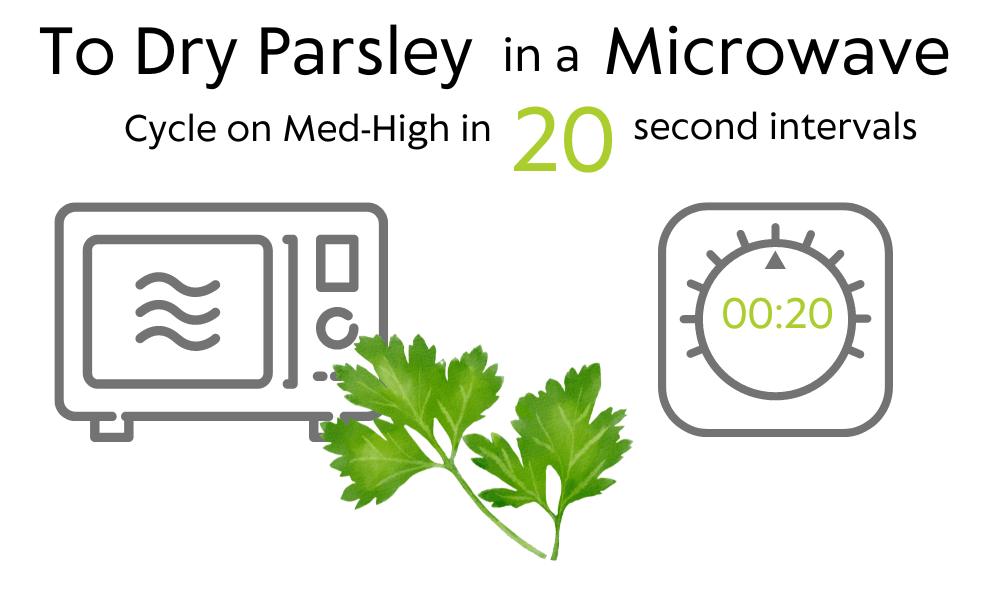
Additional Preservation Methods for Parsley
Some other ways to preserve parsley include crafting your own parsley-infused oils or parsley-flavored vinegars. Parsley herb butters are another great option for preserving parsley for various culinary applications.
Herb-Infused Oils with Parsley
One way to preserve the freshness and flavor of parsley is by making herb-infused oils. These oils can be used in various culinary applications to add a burst of parsley flavor to your dishes. Here’s a simple method to make your own:
- Wash your parsley thoroughly and pat it dry using a clean kitchen towel or paper towel
- Chop the parsley finely to release its aromatic oils.
- Place the chopped parsley into a glass jar or bottle.
- Pour olive oil over the parsley, ensuring it covers all the leaves.
- Seal the jar tightly and allow it to sit for at least two weeks, allowing the flavors to infuse.
- After two weeks, strain out the parsley from the oil using a fine-mesh sieve or cheesecloth and discard. This helps to extend shelf life and preserve the clarity of your herb-infused oils.
- Transfer the infused oil into a clean bottle or jar for storage.
Now you have your very own homemade parsley-infused oil! This versatile ingredient can be used as a dressing for salads, drizzled over roasted vegetables, or even added to marinades for meats.
To learn more about infusing oils with herbs, check out my article on 7 Best Culinary Herbs for Infused Oils (& How to Infuse Them).
Parsley Flavored Vinegars
Another preservation method is creating parsley-flavored vinegar to add zing and tanginess to any dish. Follow these steps:
- Wash and dry fresh parsley leaves.
- Finely chop the leaves and place them in a glass container with an airtight lid.
- Heat white wine vinegar in a saucepan over medium heat until it starts simmering gently.
- Pour hot vinegar over the chopped parsley, ensuring all leaves are submerged.
- Seal the container tightly and let it cool completely before storing it in the refrigerator for about three weeks.
- After three weeks, strain out the herbs using cheesecloth or a coffee filter, transferring only the flavored vinegar into a clean bottle.
Now you have a vibrant parsley-flavored vinegar that can be used as a salad dressing, added to sauces, or even used as a marinade for fish or poultry.
Parsley Herb Butter
If you’re looking for a way to preserve parsley while adding richness and flavor to your meals, making parsley herb butter is an excellent choice. Here’s how you can do it:
- Soften unsalted butter at room temperature until it becomes easily spreadable.
- Wash and dry fresh parsley leaves
- Finely chop your parsley.
- Mix the chopped parsley into the softened butter until well combined.
- Add salt and pepper to taste, along with any other desired herbs or spices.
- Shape the mixture into a log using plastic wrap and refrigerate until firm.
- Once firm, slice off portions of the herb butter as needed for cooking or spreading on bread.
This flavorful herb butter can be spread on warm crusty bread or used to enhance the taste of steamed vegetables or grilled meat.
Storing Parsley for Maximum Freshness
Ideal Storage Conditions for Dried Parsley
To ensure maximum freshness, it’s essential to store dried parsley using proper conditions. Store dried parsley in an air-tight container in a cool, dark place away from direct sunlight. Exposure to light can cause the herb to lose its vibrant green color and flavor rapidly.
Use Air-Tight Containers to Extend Shelf Life
Air-right containers create a protective seal that prevents exposure to air and moisture, which are the main culprits behind flavor deterioration and the growth of mold or bacteria. By keeping dried parsley in an airtight environment, you help to ensure its longevity and safeguard its quality for extended periods of time..
Regularly Inspecting for Quality and Mold
Even when stored correctly, dried parsley may eventually lose some flavor over time due to natural oxidation processes. It’s important to regularly inspect your stored supply for any signs of deterioration or mold growth.
If you notice any discoloration, an off odor, or the presence of mold, it’s best to discard the affected portion immediately. To prevent spoilage and ensure long-lasting freshness, consider dividing your dried parsley into smaller portions and storing them separately.
By following these techniques, you can store dried parsley for up to a year.
Conclusion: Mastering Parsley Harvesting
Mastering the art of parsley harvesting and preservation equips you with an array of techniques to savor this herb’s essence all year round. From air drying to infused oils, flavored vinegars, and herb-infused butter, each method offers a unique way to harness parsley’s distinctive flavor. By embracing these preservation methods, you can prolong the life of your parsley and elevate your culinary creations with the vibrancy it brings well beyond the growing season.
Frequently Asked Questions (FAQs)
Can I harvest my parsley multiple times throughout the year?
Parsley is known for its ability to regrow after being harvested. By regularly trimming off outer stems rather than uprooting the entire plant, you can enjoy multiple harvests throughout the year.
Can I harvest parsley during the winter months?
Parsley is a hardy herb that can withstand cooler temperatures. With proper protection, such as covering the plants with a frost cloth, you can continue harvesting parsley even during the winter months in milder climates.
How long does freshly harvested parsley last?
When stored properly, fresh parsley can last up to 5 days in the refrigerator. Remember to keep it hydrated by wrapping them in a damp paper towel.
Will parsley grow back after cutting?
Parsley will regrow after cutting. Regular harvesting of the outer leaves promotes new growth and prevents the plant from becoming too woody. Regular harvesting from the outside of the plant maintains healthy stems for continuous regrowth and a bountiful supply of fresh parsley through the growing season.
Should I let parsley flower?
It’s best not to let parsley flower. Flowering signals the end of the plant’s lifecycle. Once flowering begins it can affect both flavor and leaf production. To encourage continuous growth, pinch off flower buds as they appear and focus on leaf harvest.
What is the best type of parsley to harvest for cooking?
For culinary use, two prevalent parsley varieties are curly parsley and Italian parsley. Curly parsley features tightly curled leaves with a gentle taste, whereas Italian parsley, also called flat-leaf parsley, boasts a robust flavor and a sturdy texture.
Check out our guide on the best types of parsley for cooking for more information.
What grows well with parsley?
Parsley is a great companion plant to herbs such as basil and chives, as well as to vegetables like asparagus, tomatoes, beans, peppers, and corn. Parsley companion planting provides advantages like repelling pests and supporting robust plant development.
Last Updated on 25 October 2023 by Bob Lee

